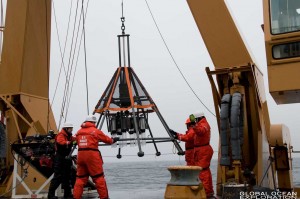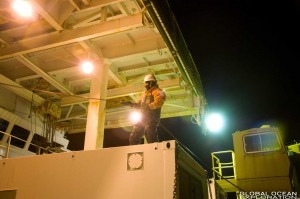LTJG Stephen Elliot and MST1 Chuck Bartlett assist scientists deploy the multi-core, a sea floor sampling device.
Â
The science conducted on the ship is dependent on the successful deployment of the marine sampling equipment from the multi-core to the sediment trap to the plankton nets to the CTD. While the operation and positioning of the boat at a sampling location is conducted up on the Bridge, the Marine Science Technicians (MSTs) play a vital role in the work conducted by the scientists on deck. They help to deploy and recover all of the sample collecting instruments and enable the scientists to complete their experiments. They are an invaluable resource to the science party. Â

MST2 Tiffany Wright recovers the sediment trap and carefully hands the samples to the scientist.
Â
MST1 Rich Layman straightens the winch cable before deploying the MOCNESS, a multiple net sampling device designed to collect plankton samples at various depths.Â
Â
The job of an MST in the Coast Guard is usually a land-based job, but two ships have MSTs, both of which operate in the Arctic. The Healy is unique in that her mission is to contribute to the advancement of science and our understanding of Arctic and Sub-Arctic oceanography. When I spoke with MST1 Rich Layman and MST1 Eric Rocklage about being an MST aboard the Healy, they had nothing but positive things to say and told me how much they enjoyed the direct contact and involvement with the science being conducted on board. Working with the science party and out on deck with the sampling instruments provided a unique opportunity in the Coast Guard and the science party values their hard work and dedication tremendously. The MSTs are truly an important element in getting the science accomplished aboard the Healy.
MST1 Eric Rocklage prepares the CTD to be deployed. He must make sure that the ice does not interfere with the cable.
Â
MST3 Tom Kruger retrieves a Van Veen Grab which is sent to the bottom to collect mud and the critters living on the sea floor.Â
  Â
Â




